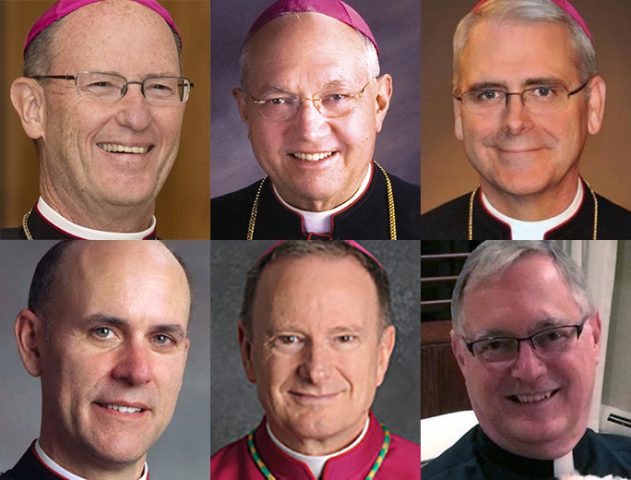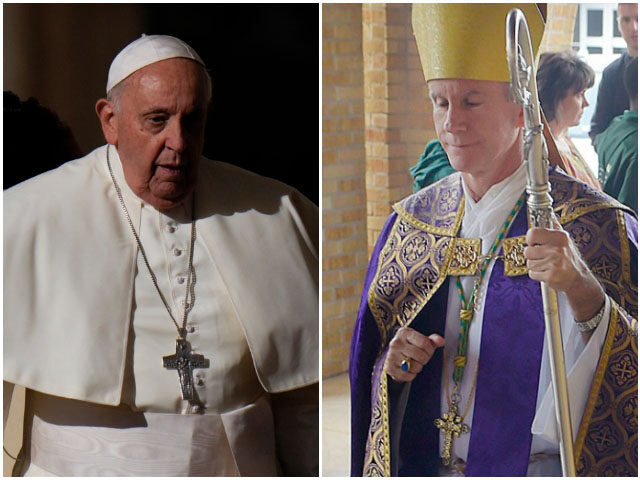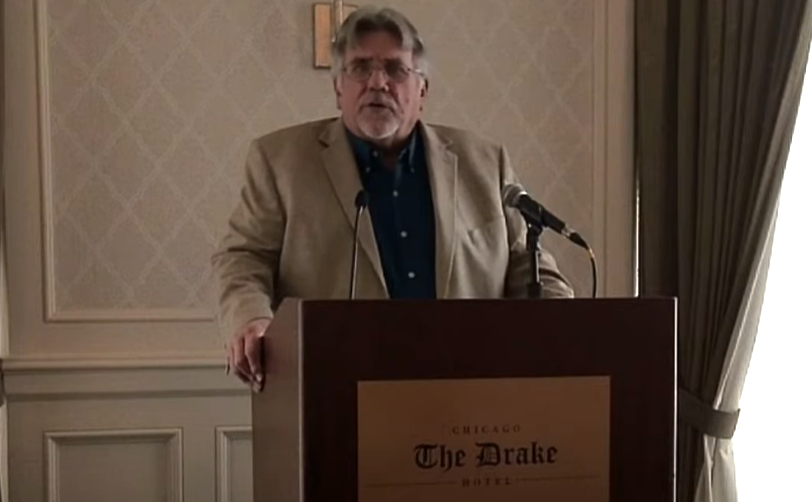Picture: TOP (L to R): Bishop Conley, Bishop Morlino, Archbishop Coakley. BOTTOM: Bishop Rhoades, Bishop Barber, Bishop Tobin.
Interesting facts about Archbishop Coakley and Bishops Barber, Conley, Morlino, Rhoades and Tobin
In the spirit of “Little-Known Facts About 7 North American Bishops,”here are some interesting facts about six diocesan bishops in the United States:
1. Bishop of Oakland, California, Michael Barber, in addition to being diocesan bishop, has been a commissioned officer for the U.S. Navy Reserve for 27 years.
In 1991, while studying in Rome, he was asked to celebrate Mass onboard naval vessels heading to and from the First Gulf War. He was told, “Father, the next time you come aboard, we’re going to get you some [U.S. Navy Chaplain Corps] gold stripes for your suit.”
After meeting Navy chaplains and a period of prayer, he requested and received permission from his superiors (he’s a Jesuit) to join the U.S. Navy Reserve.
2. Archbishop of Oklahoma City, Oklahoma, Paul Coakley led the Catholic response to a group of Satanists who wanted to hold public “Black Masses” and desecrate a Host in 2014 and a statue of the Blessed Mother in 2016. With legal assistance he was able to secure the return of the Host, but was not able to persuade community officials to deny the Satanists use of the community civic center.
Of the higher profile 2014 event, he recalled, “We set up a whole schedule of prayer. We knew about the 2014 event a few months beforehand, so I asked all of our parishes to begin praying the Prayer to St. Michael. I asked our priests to hold Eucharistic Holy Hours and Benedictions in honor of the Blessed Sacrament. On the day of the event, we invited our people to a Eucharistic adoration at a nearby parish. It included a procession and other activities in honor of the Blessed Sacrament.”
The response by the Catholic community in Oklahoma City, he said, was excellent.
3. Bishop of Lincoln, Nebraska, James Conley is a convert to Catholicism. He grew up in Kansas in a nominally Presbyterian family, and became a Catholic at age 20 after reading the “Great Books” of Western Civilization at the University of Kansas. His favorites included the Confessions of St. Augustine and the writings of Blessed John Henry Newman.
Bishop Conley’s father was “not too happy” about his conversion—he told him he’d given up the freedom of thinking for himself—but both he and Bishop Conley’s mother converted to Catholicism themselves in 1991. Bishop Conley administered Baptism and Confirmation to each.
4. In 2008, the dissident Catholic group Call to Action placed a full-page open letter in the Wisconsin State Journal criticizing the leadership of Bishop of Madison Robert Morlino. He has served as Bishop of Madison since 2003.
Bishop Morlino said, “I pray for people in Call to Action. I feel badly that they’re committed to what they’re doing as a good. It causes tremendous division within the Church. And, to try to organize the people against the bishop who is doing nothing but what the Church is teaching is a harmful thing. It grieves me.”
5. Bishop of Fort Wayne-South Bend, Indiana, Kevin Rhoades knew Mother Teresa and worked with the Missionaries of Charity. He’d celebrate Mass for the sisters, and sometimes Mother Teresa would be there. He said, “She was my hero … Now, how do you preach a homily for Mother Teresa? I loved her simplicity. I loved the joy she and her sisters had.”
Bishop Rhoades recalled one occasion during which Mother Teresa “gave me a holy card, with an image of Jesus scourged and bloody with hands tied. At the bottom were the words ‘I looked for someone to comfort me and there was no one.’ Mother Teresa had added the words ‘Be the one!’ I still keep that holy card in my breviary.”
6. Bishop of Providence, Rhode Island, Thomas Tobin’s “best friend” is a little white Cockapoo dog named Annie, after Little Orphan Annie. He adopted the dog in 2014 after his previous dog died. He frequently posts photos of her on his social media.
He said, “I adopted Annie when her previous owner was no longer able to care for her. I spend more time with her than anyone else. I think a dog will keep you young, and provide you with great company. Annie has a great personality. It also helps humanize me and the Office of the Bishop. When we’re together, she’s in charge, which is a good thing!”







